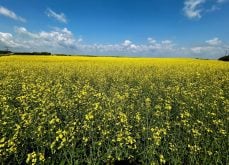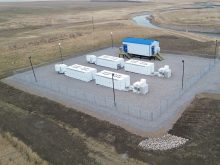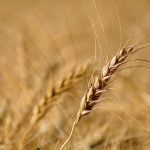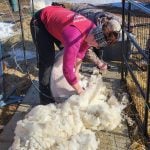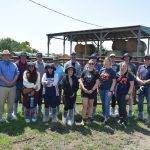Of all the events that have helped spur development of the meat goat industry in Canada, Stan Johnston considers the introduction of the Boer goat breed as pivotal.
Only a decade ago, the introduction of Boer goats started with the import of embryos from New Zealand. The following year, Canadian producers began to tap the genetics of South African Boer goats, which were of superior quality.
Johnston believes there are now about 50,000 goats in Canada that have the Boer goat influence in their bloodlines, either as purebreds or crossbreds.
Read Also

Above average temperatures expected
July was a cooler than average month right across the Prairies, with most places coming in just slightly below average.
“The Boer goat has made the meat goat industry in Canada,” said Johnston, who raises purebreds with his wife Joyce near Darlingford, Man. “The industry has been growing at a tremendous rate.”
Before the introduction of the Boer breed, Canadian producers had little choice but to use dairy goats as meat goats. For the larger producers, selling culled dairy goats for meat was a sideline to their main enterprise.
Johnston said the smaller producers did not raise large enough numbers to have any clout in the marketplace, making it difficult for them to pry good prices from buyers.
“There were mainly local markets where people generally got poorer prices.”
The Boer goat breed brought improved weight gains and carcasses that dressed out heavier than dairy goats. Crossed with dairy goats or raised as purebreds, the Boer breed and the related expansion of the meat goat industry enabled producers to market in larger quantities and command better prices, Johnston said.
It also enabled producers to look further afield for markets. The United States and Ontario became two of the main markets for meat goats raised on the Prairies.
The U.S. has blocked imports of goats from Canada as part of its reaction to the bovine spongiform encephalopathy case. Although BSE has not been found in goats, they were included under the import ban because they are also ruminants.
Johnston said there is still room to improve the quality of the Boer goat breed in Canada. An outbreak of foot-and-mouth disease in South Africa stalled imports of embryos from there, but he said there is now a good range of quality genetics in North America.
“The bar is being raised every year,” he said. “If a purebred breeder is satisfied to maintain the status quo, then he’s going to be bypassed in the show ring.”
There may not be a need to continue breeding for size, since animals that grow too large may not be as
efficient at gaining weight. However, there are other building blocks. Johnston said the choice of herd sires is critical for a herd’s development.
“The buck is the most important. It’s half your herd… Scrimping on the buck, in the long term, is the worst thing you can do.”





